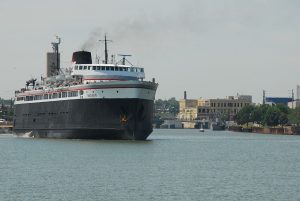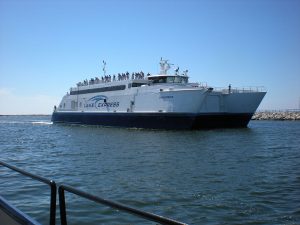As railroads revolutionized the transportation of goods and passengers around the United States in the nineteenth century, they confronted a problem: bodies of water too big to build tracks across. The solution to this problem was car ferries, special vessels that carried railroad cars, goods, and passengers across waterways. The first self-propelled car ferry, the Leviathon, was built in Scotland in 1849. Car ferries were introduced to the Great Lakes shortly afterwards by the Buffalo & Lake Huron Railway Company.[1] As Milwaukee heavy manufacturing increased in the late nineteenth century, car ferries allowed the transport of loaded railroad cars across Lake Michigan.
The Pere Marquette Railway dominated the area’s car ferry traffic, running thirteen routes over the first half of the twentieth century.[2] Most initially transported freight, but over time they added passenger accommodations. Each ship could carry roughly thirty standard-sized rail cars. Between 1907 and 1910, the Pere Marquette carried up to five thousand passengers between Chicago and Waukegan daily before returning to freight duty.[3] The Pere Marquette Railway expanded their passenger accommodations after the First World War, becoming known for luxurious accommodations and customer service.[4]
The life of a crewman on a car ferry was difficult and hazardous. The normal work schedule was six hours on six hours off, seven days a week.[5] In the colder months, ice was a constant obstacle. Men used pike poles to crack open a path. Vessels were designed with thicker hulls to allow safe navigation through dangerous, cold waters.[6]
As automobile traffic increased in the United States, car ferries were redesigned to accommodate them. The S.S. Badger is the last coal-fired steamship operating in the United States. Christened with a bottle of Champagne in 1953, the S.S. Badger still runs between Manitowoc, WI, and Ludington, Michigan.[7] Although long-distance travel by ferry declined in the late twentieth century, Charles Conrad formed the Lake Michigan Carferry Service in 1992 to protect Manitowoc’s local economy against industrial decline. The S.S. Badger carries passengers and their vehicles, including cars, vans, RVs, motorcycle, and even commercial trucks.[8] The Lake Express, a high-speed ferry, transports passengers and cars between Milwaukee and Muskegon, Michigan, from May through October.[9]
Footnotes [+]
- ^ George W. Hilton, The Great Lakes Car Ferries (Berkeley, CA: Howell-North Books, 1962), 1.
- ^ Art Chavez, S.S. Badger: The Lake Michigan Car Ferry (Chicago, IL: Arcadia Publishing, 2003), 7.
- ^ Chavez, S.S. Badger, 14.
- ^ Chavez, S.S. Badger, 16.
- ^ Chavez, S.S. Badger, 16.
- ^ Chavez, S.S. Badger, 13.
- ^ Chavez, S.S. Badger, 33
- ^ S.S. Badger A National Historic Landmark, S.S. Badger website, accessed March 16, 2019.
- ^ 2019 Lake Express Schedule, Lake Express website, last accessed April 7, 2019.
For Further Reading
Brown, Grant, Jr. Ninety Years Crossing Lake Michigan: The History of the Ann Arbor Car Ferries. Ann Arbor, MI: University of Michigan Press, 2008.
Chavez, Art. S.S. Badger The Lake Michigan Car Ferry. Mount Pleasant, SC: Arcadia Publishing, 2003.
Hilton, George W. The Great Lakes Car Ferries. Berkeley, CA: Howell-North Books, 1962.



0 Comments
Please keep your community civil. All comments must follow the Encyclopedia of Milwaukee Community rules and terms of use, and will be moderated prior to posting. Encyclopedia of Milwaukee reserves the right to use the comments we receive, in whole or in part, and to use the commenter's name and location, in any medium. See also the Copyright, Privacy, and Terms & Conditions.
Have a suggestion for a new topic? Please use the Site Contact Form.